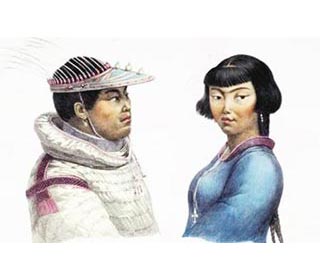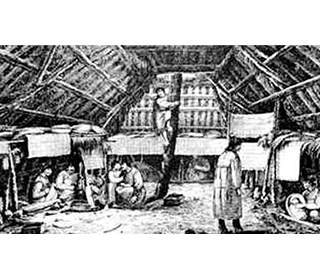Facts about the Aleut Native Indian Tribe: Lifestyle and Culture
Their name is derived from the Aleut word 'allithuh' meaning "coastal people" but they were called Aleut by Russian fur traders. At one time they were referred to as "Eskimo" which was a general used to described the Aleut, Yupik and Inuit people. The people call themselves "Unangan". The Aleutian Islands, with their 57 volcanoes, consist of a chain of 14 large and 55 small islands. The Aleutian Islands of Alaska comprise of five groups: the Fox Islands, the Islands of Four Mountains, Andreanof Islands, Rat Islands and the Near Islands. The chief source of food for the Aleut people were whales, sea lions, seals and walruses. Different types of fish, and shellfish were also part of their diet, as were wildfowl and Arctic birds. The Aleut lived in sod-covered houses called barabaras. What language did the Aleut tribe speak?
The Aleut language belongs to the Eskimo-Aleut language family and includes three dialects: Eastern Aleut, Shumagin spoken on the Fox and Pribilof Islands and the Atkan dialect , spoken on Atka and Bering islands. Where did the Aleut tribe live?
The Aleut are people of the Arctic Native American cultural group. The geography of the region in which they lived dictated the lifestyle and culture of the Aleut tribe. - Climate and Land: The climate of the Aleutian islands is oceanic, with moderate and fairly uniform temperatures with frequent fogs, high winds and heavy rainfall with a volcanic landscape.
- Animals: The animals included beaver, seal, sea lions, fox, arctic hare, whale, otter, walrus and Artic birds
- Natural Resources: Fish, shellfish, clams, plants, kelp and wild celery
- Transport: Leather-covered, watertight canoes and open fishing boats such as the Aleut Kayaks
What did the Aleut tribe live in?
The Aleut people lived in semi-subterranean, sod-covered, arched-roofed structures called barabaras. The features of the Barabara style of house were as follows: - A Barabara was an oblong, semi-subterranean, sod-covered, arched-roofed structure, similar to the pit houses built by Native American Indians
- Barabaras varied in size but it was not unusual for large houses to be built measuring 50 feet long by 20 feet wide to accommodate a family of 20people
- Whale bones or wooden beams, generally driftwood, were set into the floor to support walls and the roof
- Grass mats were placed on top of the beams and then covered with layers of sod (pieces of turf)
- A square opening was left in the roof by which access to the barabara was gained using a ladder. The roof opening also provided light and air
- The interior of the barabara consisted of one large room with a communal area and a hearth for cooking. Around the sides were partitioned sections and storage facilities created by grass mat dividers
|

